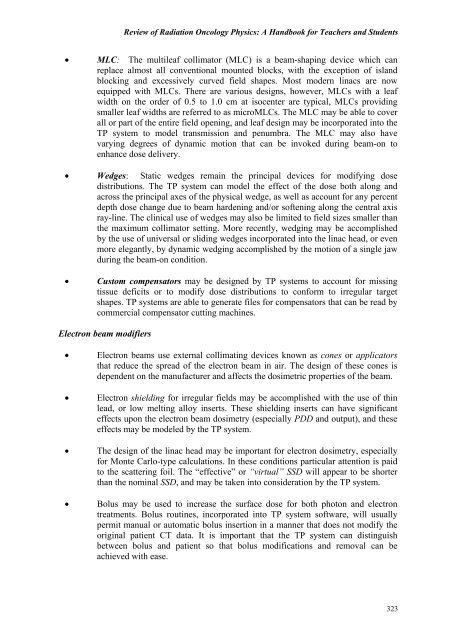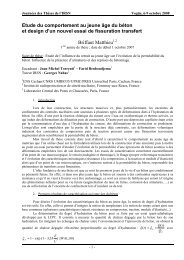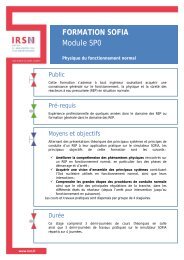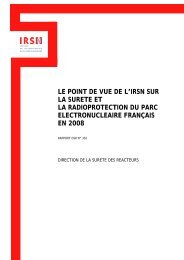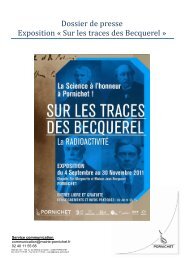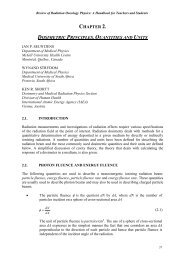Review of Radiation Therapy Physics: A syllabus for teachers ... - IRSN
Review of Radiation Therapy Physics: A syllabus for teachers ... - IRSN
Review of Radiation Therapy Physics: A syllabus for teachers ... - IRSN
You also want an ePaper? Increase the reach of your titles
YUMPU automatically turns print PDFs into web optimized ePapers that Google loves.
<strong>Review</strong> <strong>of</strong> <strong>Radiation</strong> Oncology <strong>Physics</strong>: A Handbook <strong>for</strong> Teachers and Students• MLC: The multileaf collimator (MLC) is a beam-shaping device which canreplace almost all conventional mounted blocks, with the exception <strong>of</strong> islandblocking and excessively curved field shapes. Most modern linacs are nowequipped with MLCs. There are various designs, however, MLCs with a leafwidth on the order <strong>of</strong> 0.5 to 1.0 cm at isocenter are typical, MLCs providingsmaller leaf widths are referred to as microMLCs. The MLC may be able to coverall or part <strong>of</strong> the entire field opening, and leaf design may be incorporated into theTP system to model transmission and penumbra. The MLC may also havevarying degrees <strong>of</strong> dynamic motion that can be invoked during beam-on toenhance dose delivery.• Wedges: Static wedges remain the principal devices <strong>for</strong> modifying dosedistributions. The TP system can model the effect <strong>of</strong> the dose both along andacross the principal axes <strong>of</strong> the physical wedge, as well as account <strong>for</strong> any percentdepth dose change due to beam hardening and/or s<strong>of</strong>tening along the central axisray-line. The clinical use <strong>of</strong> wedges may also be limited to field sizes smaller thanthe maximum collimator setting. More recently, wedging may be accomplishedby the use <strong>of</strong> universal or sliding wedges incorporated into the linac head, or evenmore elegantly, by dynamic wedging accomplished by the motion <strong>of</strong> a single jawduring the beam-on condition.• Custom compensators may be designed by TP systems to account <strong>for</strong> missingtissue deficits or to modify dose distributions to con<strong>for</strong>m to irregular targetshapes. TP systems are able to generate files <strong>for</strong> compensators that can be read bycommercial compensator cutting machines.Electron beam modifiers• Electron beams use external collimating devices known as cones or applicatorsthat reduce the spread <strong>of</strong> the electron beam in air. The design <strong>of</strong> these cones isdependent on the manufacturer and affects the dosimetric properties <strong>of</strong> the beam.• Electron shielding <strong>for</strong> irregular fields may be accomplished with the use <strong>of</strong> thinlead, or low melting alloy inserts. These shielding inserts can have significanteffects upon the electron beam dosimetry (especially PDD and output), and theseeffects may be modeled by the TP system.• The design <strong>of</strong> the linac head may be important <strong>for</strong> electron dosimetry, especially<strong>for</strong> Monte Carlo-type calculations. In these conditions particular attention is paidto the scattering foil. The “effective” or “virtual” SSD will appear to be shorterthan the nominal SSD, and may be taken into consideration by the TP system.• Bolus may be used to increase the surface dose <strong>for</strong> both photon and electrontreatments. Bolus routines, incorporated into TP system s<strong>of</strong>tware, will usuallypermit manual or automatic bolus insertion in a manner that does not modify theoriginal patient CT data. It is important that the TP system can distinguishbetween bolus and patient so that bolus modifications and removal can beachieved with ease.323


